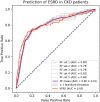Machine learning to predict end stage kidney disease in chronic kidney disease
- PMID: 35589908
- PMCID: PMC9120106
- DOI: 10.1038/s41598-022-12316-z
Machine learning to predict end stage kidney disease in chronic kidney disease
Abstract
The purpose of this study was to assess the feasibility of machine learning (ML) in predicting the risk of end-stage kidney disease (ESKD) from patients with chronic kidney disease (CKD). Data were obtained from a longitudinal CKD cohort. Predictor variables included patients' baseline characteristics and routine blood test results. The outcome of interest was the presence or absence of ESKD by the end of 5 years. Missing data were imputed using multiple imputation. Five ML algorithms, including logistic regression, naïve Bayes, random forest, decision tree, and K-nearest neighbors were trained and tested using fivefold cross-validation. The performance of each model was compared to that of the Kidney Failure Risk Equation (KFRE). The dataset contained 748 CKD patients recruited between April 2006 and March 2008, with the follow-up time of 6.3 ± 2.3 years. ESKD was observed in 70 patients (9.4%). Three ML models, including the logistic regression, naïve Bayes and random forest, showed equivalent predictability and greater sensitivity compared to the KFRE. The KFRE had the highest accuracy, specificity, and precision. This study showed the feasibility of ML in evaluating the prognosis of CKD based on easily accessible features. Three ML models with adequate performance and sensitivity scores suggest a potential use for patient screenings. Future studies include external validation and improving the models with additional predictor variables.
© 2022. The Author(s).
Conflict of interest statement
The authors declare no competing interests.
Figures
Similar articles
-
Validation of a Novel Predictive Algorithm for Kidney Failure in Patients Suffering from Chronic Kidney Disease: The Prognostic Reasoning System for Chronic Kidney Disease (PROGRES-CKD).Int J Environ Res Public Health. 2021 Nov 30;18(23):12649. doi: 10.3390/ijerph182312649. Int J Environ Res Public Health. 2021. PMID: 34886378 Free PMC article.
-
Validation of the kidney failure risk equation for end-stage kidney disease in Southeast Asia.BMC Nephrol. 2019 Dec 4;20(1):451. doi: 10.1186/s12882-019-1643-0. BMC Nephrol. 2019. PMID: 31801468 Free PMC article.
-
The Kidney Failure Risk Equation for prediction of end stage renal disease in UK primary care: An external validation and clinical impact projection cohort study.PLoS Med. 2019 Nov 6;16(11):e1002955. doi: 10.1371/journal.pmed.1002955. eCollection 2019 Nov. PLoS Med. 2019. PMID: 31693662 Free PMC article.
-
Artificial Intelligence to Predict Chronic Kidney Disease Progression to Kidney Failure: A Narrative Review.Nephrology (Carlton). 2025 Jan;30(1):e14424. doi: 10.1111/nep.14424. Nephrology (Carlton). 2025. PMID: 39763163 Review.
-
Performance of prediction models for nephropathy in people with type 2 diabetes: systematic review and external validation study.BMJ. 2021 Sep 28;374:n2134. doi: 10.1136/bmj.n2134. BMJ. 2021. PMID: 34583929 Free PMC article.
Cited by
-
Prediction of acute and chronic kidney diseases during the post-covid-19 pandemic with machine learning models: utilizing national electronic health records in the US.EBioMedicine. 2025 May;115:105726. doi: 10.1016/j.ebiom.2025.105726. Epub 2025 Apr 26. EBioMedicine. 2025. PMID: 40288236 Free PMC article.
-
The genetics and pathogenesis of CAKUT.Nat Rev Nephrol. 2023 Nov;19(11):709-720. doi: 10.1038/s41581-023-00742-9. Epub 2023 Jul 31. Nat Rev Nephrol. 2023. PMID: 37524861 Review.
-
Prediction of Vascular Access Stenosis by Lightweight Convolutional Neural Network Using Blood Flow Sound Signals.Sensors (Basel). 2024 Sep 12;24(18):5922. doi: 10.3390/s24185922. Sensors (Basel). 2024. PMID: 39338665 Free PMC article.
-
Dynamic survival prediction of end-stage kidney disease using random survival forests for competing risk analysis.Front Med (Lausanne). 2024 Dec 11;11:1428073. doi: 10.3389/fmed.2024.1428073. eCollection 2024. Front Med (Lausanne). 2024. PMID: 39722823 Free PMC article.
-
Data-driven rapid detection of Helicobacter pylori infection through machine learning with limited laboratory parameters in Chinese primary clinics.Heliyon. 2024 Aug 2;10(15):e35586. doi: 10.1016/j.heliyon.2024.e35586. eCollection 2024 Aug 15. Heliyon. 2024. PMID: 39170567 Free PMC article.
References
Publication types
MeSH terms
LinkOut - more resources
Full Text Sources
Other Literature Sources
Medical
Miscellaneous


